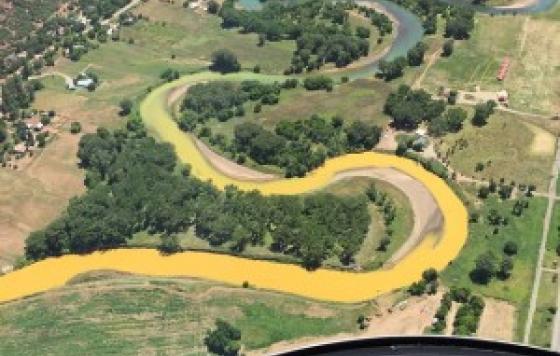By Gary Wockner, Colorado Program Director
This was originally published at EcoWatch
The river raced. I was standing near the bridge on College Avenue over the Cache la Poudre River in Fort Collins, CO. Due to the torrential rainstorms, the river had peaked about six hours earlier in the middle of the night, but it was still flowing about 100 times bigger than it usually does in September. A huge tree raged along in the floodwaters, smacked up against the bridge with a cracking sound, and then disappeared under the bridge. Spectators oohed and aahed–a couple dozen of us were watching, mostly because almost everyone in this town of 160,000 people had nothing else to do. The river, which encircles most of the roads leading out of town, rose up and closed down every bridge. We watched and stared and took pictures.
Gary Wockner, on the edge of the Cache la Poudre in Fort Collins, doesn’t want to see its water diverted. Photo credit: Hyoung Chang, The Denver Post
The river spoke in ways I never could.
I am an environmental activist. I became a working environmental activist because of this river, the Cache la Poudre. When I moved to Fort Collins 13 years ago with two small children, we bought a house just two blocks away from the river and played and played in the rocks and sand and water along the river, a wonderful activity for kids and for dads too. And so when I heard about a proposal to build a big dam that would drain and destroy the river, my adult friends and I stood up and started taking action. Activism is like that–you dip in your foot, and then your whole body is soon engulfed, and you become activated to protect and defend what you love.
As a part of my work as a river activist, two years ago I was appointed to a Floodplain Working Group for the City of Fort Collins, on which I tried to encourage a group of developers and business people to take flooding seriously and to not build homes and businesses in the Cache la Poudre River’s 100-year floodplain. I was not successful, and was voted down 12-1 repeatedly in these meetings. And it got ugly–I was called derogatory names and funders quit funding our organization because I was trying to protect human life and property and protect the river itself. I was “standing in the way of progress.” And then the developers started browbeating the City Council, threatening their re-elections. A majority of the Council caved in, including my pathetic City Councilman who I regret supporting and donating $75 for his campaign, leaving Fort Collins with very weak floodplain regulations. I spoke up in those meetings and to the City Council, my passion and intensity rising, as best I could, but they didn’t listen.
On that floodplain group, I learned a lot about floods. A “50-year” flood is of moderate size that has a one-in-fifty statistical chance of occurring in any one year; a 100-year flood is much bigger and way more damaging; a 500-year flood can wipe away low-lying towns and cleave a landscape like a butcher’s knife. Along the northern Front Range of Colorado–from Boulder to Longmont to Loveland to Fort Collins–this September flood of 2013 ranged between a 50-year and a 500-year flood event depending on which creek or river it raged through.
If you were a betting person, you would not have predicted a massive flood in 2013 in Colorado, but with climate change and the new extreme weather it brings, all bets are off. Along the Boulder to Fort Collins mountain landscape, we’ve had three consecutive years of near-record extreme weather events–near record high snowpack in 2011, near record heat/drought/forest fires in 2012, and now near record high rainfall in 2013.
The forest fires last year in the mountains were huge and damaging in Boulder County but especially the High Park Fire west of Fort Collins in Larimer County. And then this year, the flooding and fires all mixed into a maddening fury when the torrential rain swept over the fire-burned areas. Because the fires killed the trees and charred the soil, the water raced off the landscape carrying with it trees, rocks, mud and coal-black soot which turned the Cache la Poudre River into a black debris-filled torrent. Over the last 12 months, every time it rains the Cache la Poudre River turns black; in this September 2013 flood, the river was a flooding black tornado.
The impacts of the drought, snow, fires and rain are devastating, but the role that politicians play in enabling this chaos is maddeningly worse. As just one example, our Governor, John Hickenlooper (D-CO), has been all over the board on his statements about climate change. He’s a former oilman and huge supporter of oil and gas who brags about his oily background and got national media attention when he sat in front of a U.S. Senate Subcommittee and told them he drank Halliburton’s fracking fluid. Right before he was sworn into office in 2011, he told the New York Times that we should “drill the living daylights out of natural gas” in Colorado, even though natural gas is mostly methane, a greenhouse gas that is an increasingly large contributor to climate change. Those of us in the environmental community who supported him, including me with a personal donation of $1,050 which I wish like hell I could get back now, got snookered. But now the Governor is in an awkward position because he’s had to call President Obama twice and ask for federal disaster aid to fight climate-change linked record fires in 2012 and record rain and flooding in 2013. Is the Governor listening yet?
And then there’s the oil and gas industry. Every year in Colorado they spend millions of dollars lobbying to make sure that every proposed new regulation is defeated. In Colorado this industry completely controls the state government, donating vast sums of money to the Governor, state legislators and lobbying at the federal, state and local level to gut regulations, increase their profits and further pollute the public’s health and our environment. There are 50,000 active oil and gas wells are in Colorado, and over 20,000 in Weld County alone, a county that, as this flood story unfolded, also happens to be downstream and in the path of the raging torrent.
I traveled around the northern Front Range of Colorado during the week of flooding, from Fort Collins to Boulder and Denver, and up and down I-25 corridor through the eastern portion of Weld County. As the rain poured down, the Big Thompson River coming out of Estes Park and Rocky Mountain National Park cut its winding canyon highway into pieces and flooded the city of Loveland down below. This highway is the “Gateway to Rocky Mountain National Park” and may take two years to rebuild which will likely devastate businesses in the city of Estes Park as well as the budget of Rocky Mountain National Park. In years past, I’ve hiked, skied, camped and watched elk in that park. In the fall, the aspen leaves quake, the elk bugle and the crisp clear mountain air makes you feel that life is pure and natural and never more worth living. Perhaps not this year.
The St. Vrain River to the south, also coming out of Rocky Mountain National Park, shredded the canyon road that ran beside it, marooned hundreds people in the mountains who later had to be helicopter-evacuated, partially destroyed the town of Lyons at the bottom of the canyon and flooded Longmont ten miles east on the plains. Lyons is a small and unique community, with a kayak park on the river right in town, a quaint little main street, and bluesy brew pub that attracts national performers (and me occasionally). It will be years before it is all rebuilt and alive again.
Boulder Creek, even farther south, rose up like almost never before and flooded part of downtown Boulder, air-raid sirens screaming in the night attempting to evacuate thousands of people who live along the Creek’s floodplain. Some of the smaller mountain creeks west of Boulder experienced a 500-year flood event. In the past, I’ve rode thousands of miles on a mountain bike in the pristine canyons above Boulder, including near Jamestown where my first child was born and which was damaged severely in this flood. Most of these canyons are now so covered in mud and debris and pieces of homes and lives that they may never fully physically or emotionally recover.
And then there’s Weld County, a few miles east and where the landscape flattens out and where all the creeks and rivers from the mountains flowed into the South Platte River and its wide meandering floodplain. The river rose up and spread across the land as if it had always been there, and knew exactly where to go, covering every nook and cranny–homes, oil wells, cattle feedlots, businesses and highways all submerged and be-damned.
Thousands of oil and gas wells in Weld County were submerged as the river rose. Oil and gas tanks floated along in floodwaters, and oil slicks streaked across the liquid landscape. The State government, which is supposed to regulate the industry and protect the public, has very little manpower and money (due to the endless lobbying by the oil and gas industry) to address this problem. The U.S. Environmental Protection Agency engaged, but also has limited manpower and funding. And so the oil and gas industry–which is worth about a trillion dollars–initially did their own inspections and “self-policed.” Using helicopters and boats, the industry shut down nearly 2,000 submerged wells and first reported back to the newspapers that “all’s well, nothing to see here, keep moving along.” But as the oil slicks increased, the industry changed its tune to say, “yeah, there’s a problem, but it’s small and we’re addressing it.” A day later when more chaos unfolded, the industry said, “we’re not sure of the exact scope of the problem.” And then finally, as the waters receded and a dozen spills made headlines, the industry went into a grotesque public relations spin mode and congratulated themselves for their “heroic actions” that contained the disaster. And then, sickly, Gov. Hickenlooper started parroting the industry’s talking points.
For years the industry has fought every new regulation, including those for drilling and fracking beside rivers and in floodplains. Will they ever listen?
Back in Fort Collins, the Cache la Poudre River starts on the northern edge of the continental divide in Rocky Mountain National Park, flows 80 miles down an extraordinary canyon as the only National Wild and Scenic River in the state of Colorado, and then spills on to the plains a few miles west of Fort Collins. In this epic rainstorm event, Fort Collins got lucky because the rainfall along the Poudre River was only about half as much as in Boulder County to the south. As the water subsides, the City of Fort Collins government is surveying the damage, and now gets to decide if it’s going to build those new commercial buildings in the floodplain. At one time during our Floodplain Working Group process, the proposed regulations allowed commercial buildings in the 100-year floodplain but required that the business create elevated space inside the building, or roof access, so that when a flood comes, stranded workers (or shoppers) could stand on the roof and wait for evacuation. But, believe it or not, the developers and business people howled and ranted and even got that small regulation removed. And the City will also now decide if it should allow a little subdivision along the river within inches of the 100-year floodplain where, believe it or not, a child could step five feet beyond its driveway and get swept away by the black, muddy, debris-filled torrent. The developer has named the subdivision after a historic name given to the Poudre River, “Pateros Creek.” Be careful what you ask for, I said. Will they listen now?
I do this work for a living. I represent environmental organizations and I absolutely love what I do. I travel and speak around the state of Colorado and throughout the Southwest U.S. on issues of river protection, clean water, climate change, drought and now flooding. I speak a lot. I write a lot. I send out a lot of press releases and media updates. I blog, post, tweet. I communicate relentlessly. I also race–with my words, work and life. I try to speak loudly and make a difference.
But most people are not listening, especially the developers, the business people, almost all of the politicians, and of course the oil and gas industry whose short-term profit is the only thought on their mind, and then they buy and sell the elections and politicians to make sure that no long-term planning occurs, to make sure that the long arm of government keeps its business out of their business, until of course a human-caused disaster strikes, then who is the first in line to ask for a government subsidy and bailout?
I speak, write, text, tweet, post, blog, lobby and sometimes I yell.
But nothing I could have ever said, with voice, word, Facebook or Twitter–no press release, no blog, no instagram photo–could speak as well as the rivers did in September of 2013.
The rivers rose up and said, “I am river! Hear me roar!”
Will we listen?
Related Posts
Stay Informed
Get the latest updates and actions:
Thanks for signing up!
There was a problem processing your signup. Please try again.


